Recommendation points
- Functions of furniture fronts
- Classic materials for furniture facades
- Chipboard
- MDF
- Veneering
- Framework
- Solid wood
- Non-standard and exclusive materials
- Artificial stone
- Glass and plastic
- Blinds and roller blinds
The appearance of cabinet furniture is mainly determined by its front part, especially for kitchen sets, the development of which creates a unique ensemble of decorative and functional coatings. Today on the site we will consider how best to choose an effective and aesthetic facade for the kitchen.
Functions of furniture fronts
It may seem that furniture doors stand out only in color and texture. By no means: the range of functions of the facades is more extensive, not only the aesthetic properties of the finish play a role, but also the quality of the material from which the door is made, its functionality and durability.
Any experienced furniture assembler will be happy to tell you how painstakingly work is being done to fasten the facades to the enclosures and how strict the tolerances for distortions are. Facade doors form a strict mesh, all seams between them must have the same and the same thickness. It is equally important that these properties are preserved throughout the life of the furniture..
It is always necessary to take into account the resistance of the materials from which the facade is made to the environmental conditions in which they are used. So, due to high humidity, twisting and swelling is possible. On the other hand, heavy materials are more likely to cause sagging facades or require the use of special expensive hardware. Even the smallest manifestations of distortion or twisting hopelessly spoil the appearance of the furniture, therefore, choosing the right material for the base of the facade is the key to a neat appearance of the furniture..
Classic materials for furniture facades
It is worth starting your acquaintance with the vast “zoo” of doors for cabinet furniture with traditional materials that most furniture showrooms are ready to offer their customers. Most likely, it is the classic facades that will satisfy the requirements in terms of practicality and aesthetics..
Chipboard
This is the most primitive facade material. In the simplest case, it is the same slab material that is used as elements of the furniture body, edged on all four sides. Simplicity is expressed in cheapness, but one cannot count on a unique appearance either. Chipboard has a rather poor choice of colors and textures, besides, you are unlikely to find facades with complex milling or deeply embossed texture.
On the other hand, finishing technologies called softforming and postforming can offer more aesthetic delights, although this increases the complexity of manufacture and, accordingly, the cost of facades. So, in more detail:
Postforming is when the edges of an untreated sanded chipboard are processed with a cutter to remove a small (6-10 mm) chamfer or fillet, and then the front part and ends are pasted over with vinyl.
Softforming is almost the same, only milling can be more complex and varied: up to 60 mm at edges with different profiles, as well as milling along the plane of the slab.
MDF
The use of fibreboard as the basis for furniture facades has its advantages. MDF is highly resistant to changes in temperature and humidity, this has already been described in detail on the portal. These qualities are manifested not only because of the properties of the base material, but also because MDF facades are decorated either by postforming and softforming methods, or by painting. Thanks to this processing, the core receives an extremely high degree of isolation from environmental conditions, in contrast to inexpensive chipboard facades, the ends of which are pasted over with edges..
The difference between film coating and paints and varnishes is purely aesthetic properties. The film provides more variations in embossing and design, up to the use of photo printing. Staining, on the other hand, creates a unique play and depth of light due to a multi-layer varnish coating that undergoes polishing. In terms of quality and visual data, painting of facades is analogous to paintwork of car bodies.
Veneering
A special type of decorative coatings is natural veneer, over which a protective lamination is applied. The standard design of laminated chipboard does not have such a rich gamut of colors, while the artificial drawing has low detail and, among other things, consists of repetitive patterns. The use of veneer makes it possible to give facades an appearance identical to natural wood, including rare and valuable species. There are quite a few types of veneer, some of them very plausibly imitate exclusive types of wood, while the cost of the finished product is relatively low.
Equally important, since the facade is based on a moisture-resistant MDF board, it is not subject to warping and shrinkage inherent in natural wood. A sufficiently strong protective coating also contributes to protection from external influences. The main disadvantage of veneered facades is the impossibility of performing complex milling, since veneer is a non-plastic material and cannot repeat the complex relief of the base.
Framework
There is confusion surrounding the definition of frame facades. It is necessary to distinguish between facades made of wood-polymer plates, the ends of which are framed with an aluminum profile, and facades made of wood, the design of which is similar to paneled doors..
The first type allows you to design furniture in a restrained and laconic style. The main decor of such facades is vinyl or acrylic film used in postforming and softforming. The separation of smooth surfaces with a metal frame looks very impressive, however, the absence of even a minimal chamfer requires strict adherence to technological gaps in the design, especially on corner doors.
The second type of facades has a wooden frame with an inner groove, into which the filling material is inserted – usually veneered plywood or glass. The appearance of such facades is optimal for furniture in the grunge style, country and English kitchens. The use of composite lumber filling allows stabilizing the shape of the product and avoiding twisting of the facade over time.
Solid wood
As already mentioned, solid natural wood has a significant drawback – the ability to change shape with changes in temperature and humidity. But this does not mean at all that the choice in favor of wooden facades is irrational, everything depends on the quality of raw materials and production technology. The following techniques and solutions will help to correct the natural flaw in the tree:
- gluing furniture boards with different fiber directions;
- the use of special glue when gluing;
- stabilization of wood;
- the use of special breeds of high density;
- gluing levelers (hardened metal rods) into the facade.
Despite the indicated disadvantages, the use of wooden facades is justified, although not everywhere. The wood must be consistent with other interior elements where other natural materials are used. The main advantage of wood is that its pattern is repeated throughout the entire depth of the massif; accordingly, the complexity of carving and milling is not limited.
Non-standard and exclusive materials
If standard materials are not able to satisfy aesthetic whims, pay attention to materials that are elite in furniture production.
Artificial stone
Furniture facades are also manufactured using the technology of production of composite worktops. Due to the small thickness and dimensions, the core in the form of chipboard or MDF board may be absent; it is also customary to use embedded steel reinforcement for large-sized doors.
The main advantages of such facades are absolute shape stability and the possibility of surface restoration by polishing. There is also a significant aesthetic gain: the wide choice of mineral filler and compound makes it possible to form a completely unique texture. The key disadvantage is the high cost, due, among other things, to the high weight, which forces an increase in the number of loops and the use of special fittings.
Glass and plastic
Thin fronts are used in modern designer kitchens, wall and modular cabinets. This category also includes protruding mirror facades installed on wall cabinets in bathrooms..
The main difference between such doors is their small thickness, which in most cases does not exceed 10 mm. This makes it impossible to insert a cup with a standard hinge, which forces the use of special fittings, which are fixed mainly with an adhesive joint..
Blinds and roller blinds
In conclusion, we will consider the most specific and rare type of facades. In some cases, blinds play a purely decorative role: a set of thin lamellas acts as filling of frame facades. These doors are most typical for kitchens made in the Spanish-Portuguese and Mexican styles. The payment for the original appearance will be the complexity of cleaning: dust accumulates on hard-to-reach surfaces, which eventually eats into the pores of the material.
On the other hand, roller shutters have very useful functionality. Their installation is recommended in cases where the action of swing, sliding and lifting-and-turning mechanisms is impeded by various obstacles. The roller shutter material can be completely different: from wood and bamboo to aluminum and carbon fiber. Such systems are highly technological and occupy the most expensive positions in the catalogs of modern furniture fittings..

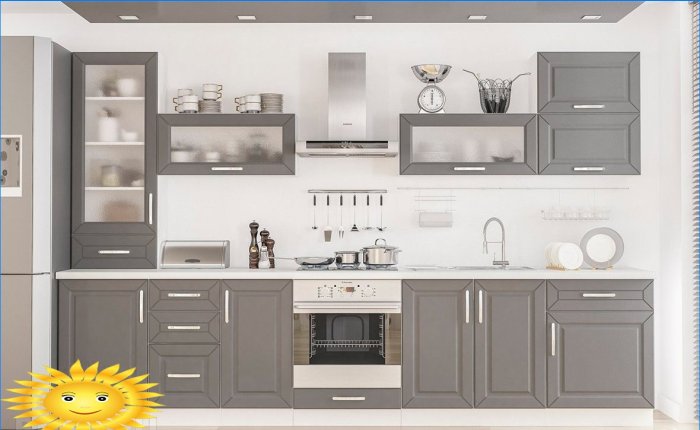
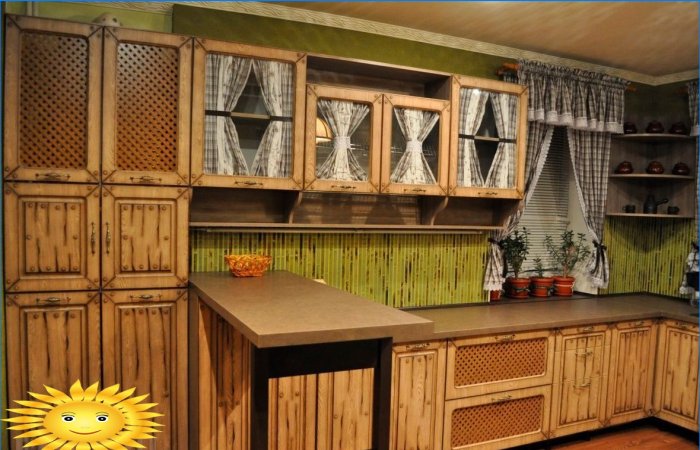
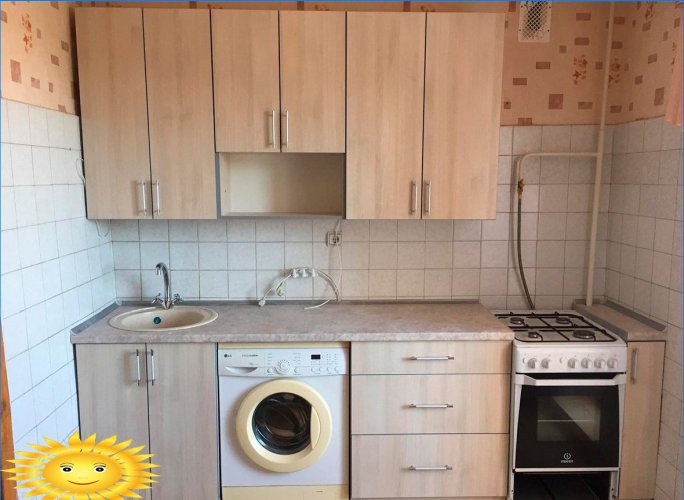

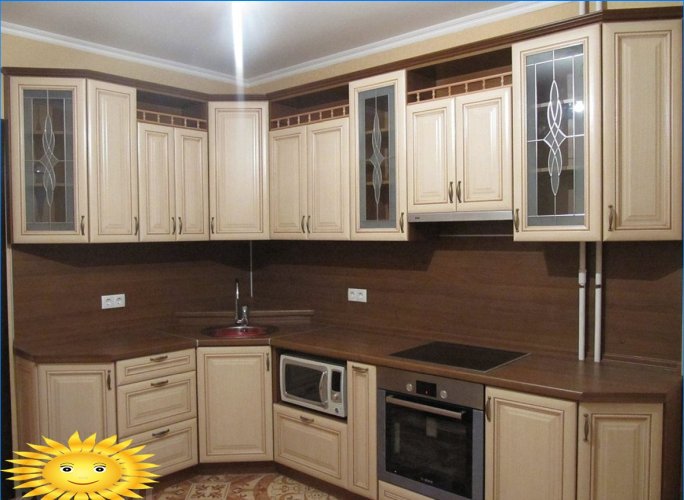
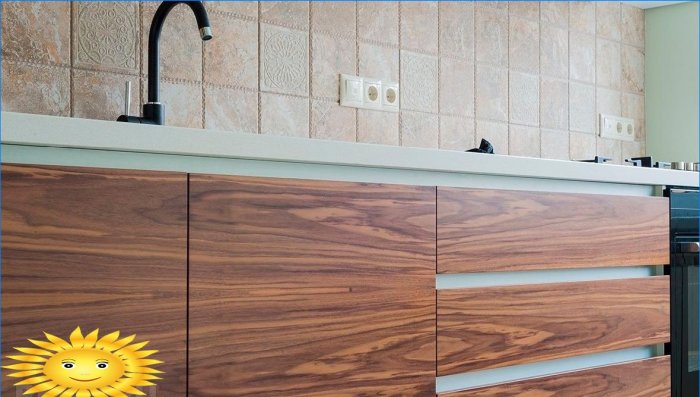
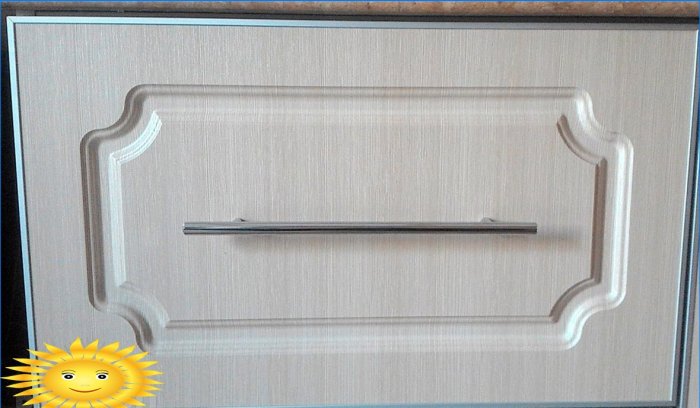
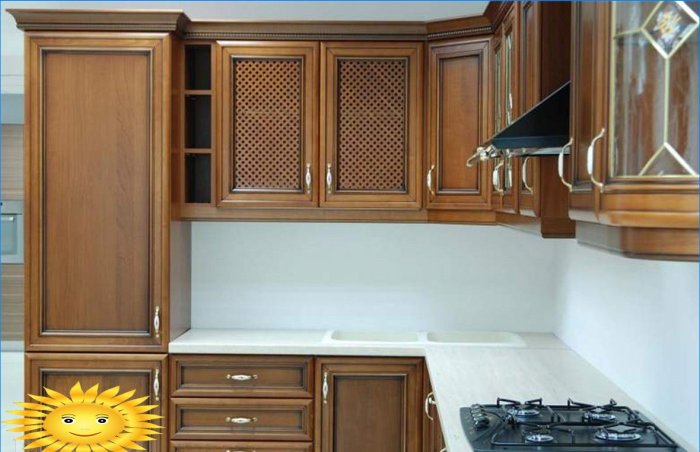

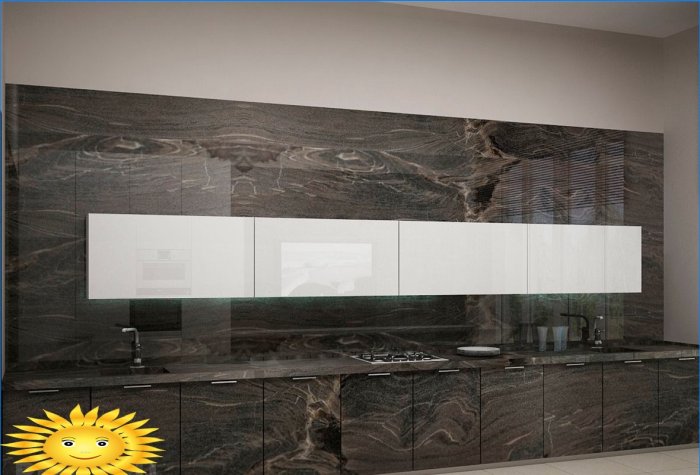
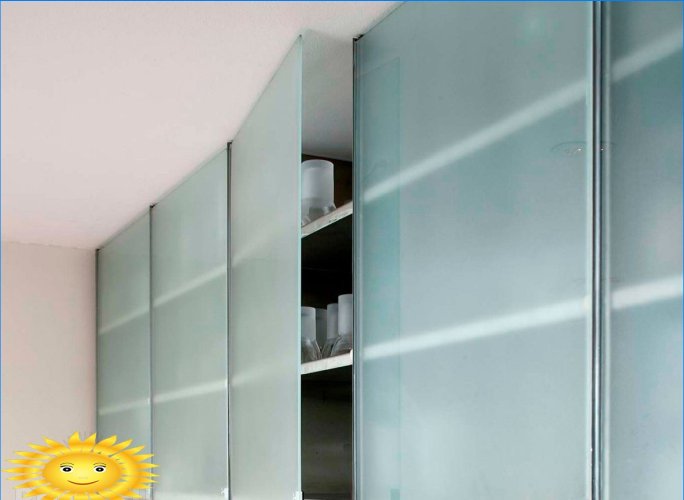

What are some popular types and features of kitchen facades that can enhance the overall look and functionality of a kitchen?
What are the different types of facades available for kitchens and what are their unique features?
What are the different types of kitchen facades available in the market? Can you please explain their features and characteristics?
There are several types of kitchen facades available in the market, each with its own unique features and characteristics. Some popular options include:
1. Shaker-style facades: These have a classic, timeless appeal with a simple and clean design. They are characterized by a five-piece door with a recessed center panel and can be made from various materials such as wood or MDF.
2. Flat-panel facades: Also known as slab or minimalist facades, these have a sleek and contemporary look. They consist of a flat door with no frames or raised panels. They can be made from materials like laminate, acrylic, or even glass.
3. Raised-panel facades: These facades feature a central panel that is raised or contoured, giving them a more detailed and traditional appearance. They are available in various wood species and finishes, providing a rich and elegant look.
4. Glass facades: These facades utilize glass panels, either as the entire door or as inserts within a frame. They offer a modern and transparent look, allowing for the display of dishes or decorative items inside the cabinets.
5. Thermofoil facades: These facades are made from a vinyl material that is heat-fused to an MDF or engineered wood base. They come in a wide range of colors and finishes, are durable, easy to clean, and resistant to moisture.
6. Custom facades: For those seeking a truly unique look, custom facades allow for personalized designs incorporating different materials, finishes, and styles tailored to individual preferences.
Ultimately, the choice of kitchen facades depends on one’s personal style, budget, and the overall design aesthetic of the kitchen.
There are several types of kitchen facades available in the market. These include natural wood, laminate, thermofoil, acrylic, and glass.
Natural wood facades offer a classic and timeless look. They are durable, can be stained or painted, and have unique grain patterns. However, they require regular maintenance and can be expensive.
Laminate facades are affordable and low-maintenance. They come in various colors and patterns, including wood and stone finishes. However, they may not be as durable as other options and can be prone to scratching and chipping.
Thermofoil facades are made of vinyl or PVC material. They are cost-effective, easy to clean, and come in numerous designs. However, they can be susceptible to heat damage and may peel over time.
Acrylic facades have a glossy appearance and are highly resistant to scratches and moisture. They are available in various colors and finishes, providing a modern and sleek look. However, they can be expensive and require proper cleaning to avoid streaks and fingerprints.
Glass facades offer a contemporary and elegant look. They come in different types, such as clear, frosted, or textured glass. Glass facades are easy to clean and can reflect light, making the kitchen appear brighter. However, they can show fingerprints easily and may require regular maintenance to keep them visually appealing.
Overall, the choice of kitchen facades depends on personal preference, budget, and desired aesthetic. It is important to consider durability, maintenance requirements, and style when selecting the right facade for your kitchen.